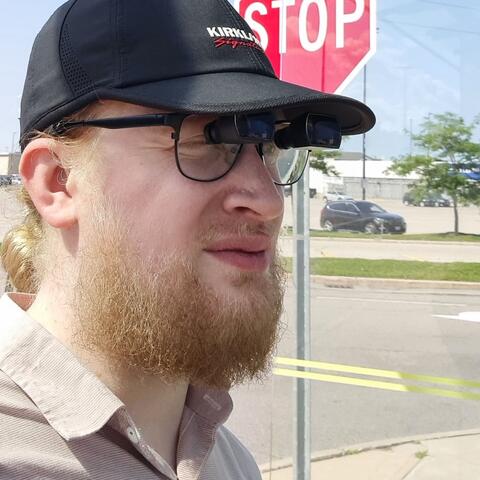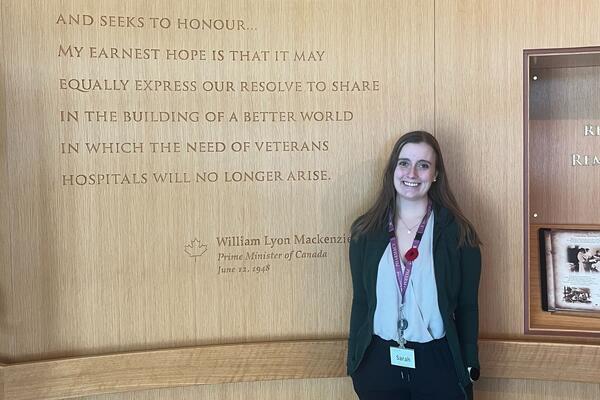
Driving toward the future
Waterloo Eye Institute Low Vision Clinic helps Syrian refugee get special glasses that will allow him to drive

Waterloo Eye Institute Low Vision Clinic helps Syrian refugee get special glasses that will allow him to drive
By Karen Kawawada School of Optometry & Vision ScienceAhmad Mahfoud has experienced many hardships and losses as a refugee from Syria. Now, though, thanks in part to the Waterloo Eye Institute at the University of Waterloo School of Optometry and Vision Science, he’s on the cusp of gaining something he never thought he’d have – a driver’s license.
Mahfoud is a patient of the Low Vision Clinic at the George & Judy Woo Centre for Sight Enhancement (CSE), which works with individuals with permanent visual impairment due to a variety of eye conditions. In addition to clinical approaches to helping patients achieve the best possible vision, staff can help patients with psychological adjustment to vision loss, training on adaptive devices and strategies, and connecting with different resources in the community.
“We work to help patients meet their needs, whether it’s reading, driving, mobility, or helping them succeed in their careers or studies,” says Dr. Tammy Labreche, director of the CSE. “We work with a variety of assistive devices, conduct onsite evaluations at workplaces and schools, and do some patient advocacy. I don’t think any other clinic in Canada does everything we do.”
“The University of Waterloo clinic has been very helpful, very kind to me,” says Mahfoud. “I cannot describe my feeling when they accepted to help me with all the things I asked for.”
Mahfoud’s story starts in Damascus, where he was born with albinism, which affects both his near and distance vision. Local optometrists prescribed glasses, but they were limited in how much they could help. In school, he always had to sit in the front row, and even then, he relied largely on his hearing and memory to learn.
After high school, Mahfoud attended university to study accounting. His first two years were successful, however when war broke out, everyday tasks such as attending lectures and exams became difficult and dangerous.
In small groups, members of his family escaped to Egypt. As soon as Mahfoud graduated, he and his father also left. They too made it to Egypt — but with only the equivalent of $200 to $300 on which to build a new life.
Mahfoud eventually found work as an accountant, but life in Egypt was difficult due to discrimination experienced by refugees. The strong sun also affected his sensitive skin, so the family applied to the United Nations for resettlement. It took five years, but in 2021, they were at last sent to Sault Ste-Marie. Mahmoud found it a beautiful place but there were few suitable jobs. When his brother found work in Cambridge, the whole family decided to move.
“When I came here, I started looking for a job, but sometimes I would have a Zoom interview and I would say, ‘I have low vision,’ and they would say, ‘Okay, we can accommodate that,’ but after, they would say, ‘Sorry, we’re not going to proceed with your application,’” says Mahfoud. “So, I started looking to see if I can find anything to help me so I don’t have to make these excuses.”
Through an assessment in Sault Ste. Marie with Vision Loss Rehabilitation Ontario (VLRO), Mahfoud received a CCTV, which is a video-based magnifier to assist with reading. Once he moved to Cambridge, VLRO referred Mahfoud to the Waterloo Eye Institute for further support.
In the meantime, not only did Mahfoud find a job in his field, he married a Syrian woman he met in Canada, so he didn’t make an appointment right away. Then he read about a 2020 law change in Ontario that opened a door to driving through the use of bioptic telescopes for drivers with low vision who meet certain criteria. He loved the idea.
“Here, driving is necessary because of the snow and cold,” says Mahfoud. “Walking in storms is very hard. And I have to be at work at 7:00, when it’s still dark. Now I take the bus or sometimes my father drops me off, but if I can drive, I won’t have to ask anyone to drive me. Feeling independent would be the greatest benefit I would get.”
Following a low vision assessment, the clinic team members agreed Mahfoud would be a good candidate for bioptic driving. As a starting point, they prescribed spectacle-mounted telescopes for distance viewing tasks in everyday life and provided several training sessions on the use of bioptics. He has been using them regularly ever since.

“If I want to cross the street, the streets are very wide, so before I needed to check with another person. Now I can just push the button and see the traffic light. I can see if the coming bus is the right bus,” says Mahfoud. “If there are meetings at work, I don’t have to sit beside the projector screen. It feels good.”
“It’s so satisfying to see patients’ quality of life improve due to the supports we’re able to provide,” says Labreche.
Following Mahfoud’s bioptic telescope training, the low vision optometrist sent a letter of recommendation to the Ministry of Transportation (MTO). Mafhoud was thrilled to recently receive a letter from the MTO advising him that he can proceed with applying for a G1V, which will allow him to attend a specialized bioptic driving training program in Barrie, Ontario. If successful, Mafhoud will proceed with the G1 licensing process as a novice driver.
Mahfoud already has big plans for when he’s fully licensed.
“I will be very comfortable in driving,” he says. “I want to get another job to make more money, so maybe I can work as an Uber driver. I want to save so I can get a better place to live. I want to say to anybody who has any kind of limitation or disability: You have to follow your dreams. Take your situation to push you to success. Don’t stop.”

Read more
Here are the people and events behind some of this year’s most compelling Waterloo stories

Read more
Waterloo pharmacy alum and Sunnybrook Health Science Centre team deliver compassionate care to those who have served in the Canadian military

Read more
More than 20 founders from Waterloo highlight the newly unveiled list that celebrates those making the biggest impact inside Canadian tech and innovation
The University of Waterloo acknowledges that much of our work takes place on the traditional territory of the Neutral, Anishinaabeg, and Haudenosaunee peoples. Our main campus is situated on the Haldimand Tract, the land granted to the Six Nations that includes six miles on each side of the Grand River. Our active work toward reconciliation takes place across our campuses through research, learning, teaching, and community building, and is co-ordinated within the Office of Indigenous Relations.